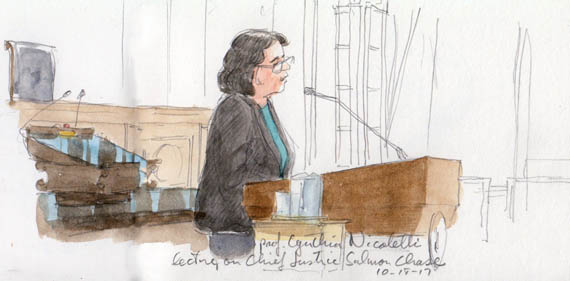Chief Justice Salmon Chase on the permanency of the Union, and Cynthia Nicoletti on Chase’s political ambitions

on Oct 20, 2017 at 3:56 pm

In Texas v. White in 1869, Chief Justice Salmon Chase famously wrote for the Supreme Court that the “Constitution, in all its provisions, looks to an indestructible Union composed of indestructible States.” Chase’s opinion rejecting state secession may seem today like a foregone conclusion, an unsurprising legal corollary to the Union’s victory on the battlefield.
For the court-watchers of the 1860s – #AppellateQuillPens – the ruling was much less obvious, especially given its author. Just one year previously, Chase had avoided reaching this holding in a different case – Jefferson Davis’ trial for treason. Chase maintained in both cases that he was following only the dictates of logic. In a lecture sponsored by the Supreme Court Historical Society, law professor Cynthia Nicoletti told a different story that suggests Chase had more personal motivations.

Professor Cynthia Nicoletti lectures on Chief Justice Salmon Chase (Art Lien)
In the aftermath of Appomattox, President Andrew Johnson wanted to charge Jefferson Davis with treason, a decisive legal step to cement victory in war. After all, there was no question that Davis, a prisoner at Fort Monroe in Virginia, had levied war against the United States, committing treason as defined in the U.S. Constitution. However, as Nicoletti observed, any case against Davis would bring into question the legality of state secession: Davis’ best defense was that he could not be charged with treason because he forfeited his U.S. citizenship upon the secession of the Confederate states.
According to Nicoletti, Johnson and his attorney general, James Speed, worried about raising the issue of secession because they thought they might lose in open court – having already dismissed the possibility of charging Davis before a military tribunal for fear that Southerners would reject a guilty verdict as illegitimate. Under the Constitution, Davis could only be charged in Richmond, where he had marshalled his army against the United States. And in a trial in Richmond before Virginian jurors, just one obstinate juror could have single-handedly prevented conviction.
Nicoletti went on to suggest that one judge – Chase – also factored into Johnson and Speed’s prosecutorial calculus. At that time, a judge from district court and a justice from the Supreme Court jointly presided over trials for major federal crimes, including treason. Chase, who was responsible for “riding circuit” in Virginia (full courts of intermediate appellate review had not yet developed), would be one of the two judges presiding over Davis’ trial.
Nicoletti explained that as governor of Ohio before the outbreak of the Civil War, Chase was a strong advocate for states’ rights – not because of support for slavery, but out of opposition to it. Chase firmly opposed the Fugitive Slave Act, a federal law that infringed on the rights of states, like Ohio, by forcing them to support the institution of slavery. Johnson and Speed worried about putting Chase to a tricky choice – acquit Davis or retreat from his earlier support for state sovereignty.
As Nicolleti pointed out, not every Northerner necessarily opposed state secession. For instance, Thaddeus Stevens, a leader of the radical wing of the Republican party, supported the recognition of the Confederacy as an independent nation. Stevens wanted greater federal and military pressure on the Confederate states to protect the civil rights of former slaves – a position that required the region to be treated legally as conquered territory, not as states. (Stevens believed in this idea so strongly that he even offered to serve as Davis’ lawyer. Davis refused.)
According to Nicoletti, Chase made every effort to avoid deciding the Davis case. For instance, he argued in private to Johnson that the state of martial law in Virginia infringed on his ability to hold a fair trial. In 1866, Johnson loosened the military presence. Chase complained that it wasn’t enough. Johnson loosened it further. Once Chase ran out of other excuses, he simply didn’t show up at key legal events.
As Nicoletti told it, Chase found his way out of the case through the 14th Amendment in 1868 – three years after Davis’ original capture. Section 3 of the amendment prohibited former members of the Confederacy from holding office. Chase reasoned that this provision limited the government’s ability to impose further punishment on Confederates. Chase even took the step of inviting Davis’ lawyer to a private meeting to express this view.
After Davis’ lawyer repeated these arguments at trial, Chase ruled for the defendant, without endorsing state secession, although the district court judge disagreed. The prosecution chose not to appeal the case to the Supreme Court.
Less than a year later, Chase issued his ruling in Texas v. White. This case reached the Supreme Court on original jurisdiction – but the court could hear the case only if Texas had in fact remained a state during the Civil War. Chase supported his holding that Texas never left the Union with arguments made by President Abraham Lincoln in his first inaugural address: The Articles of Confederation explicitly pronounced the union perpetual, and the preamble to the Constitution said it made the union “more perfect.”
Unlike the Davis trial, Texas v. White attracted little attention or publicity. Most newspapers focused on another case handed down the same day and ignored this one.
What explains Chase’s seeming shift on state sovereignty? Nicoletti suggested that the issue was never Chase’s primary concern. Instead, Chase primarily saw the Davis case through the lens of his presidential ambitions. Chase had run against Lincoln for the Republican nomination in 1860, and Lincoln nominated him to the Supreme Court in 1864 in large part to avoid a primary challenge. At the same time as the Davis trial in 1868, Chase was actively running for president – as a Democrat. Given his party affiliation, Chase feared alienating Democratic Southerners by convicting Davis.
Chase had little to gain from the Davis trial, but a lot to lose. So he punted. A year later, having again failed in his presidential bid, Chase seized a chance to slip a major ruling into an otherwise inconsequential case. Throughout both cases, Chase maintained that he only followed logic. Looking at his actions, Nicoletti suggests otherwise.
Nicoletti spoke as part of the historical society’s 2017 Leon Silverman Lecture Series, which this year focuses on Supreme Court justices and presidential cabinets. On November 1, professor John Barrett will give a lecture entitled “Attorney General Robert H. Jackson and President Roosevelt.” And December 6, Sidney Milkis will give a lecture entitled “Answering the Call: Leaving the Bench to Serve the President – James F. Byrnes and FDR.” More information is available on the society’s website.


